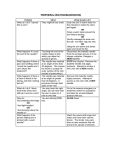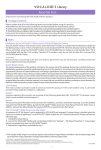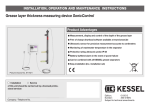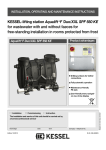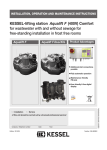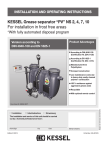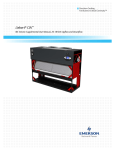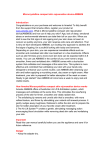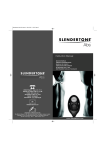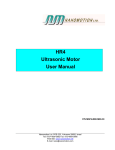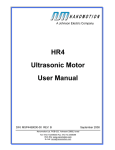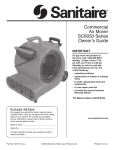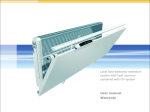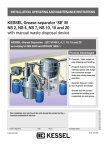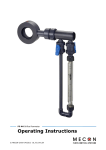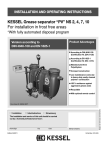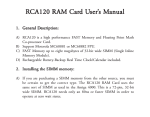Download or Alarm System with optical sensor (Article number 20221)
Transcript
INSTALLATION, OPERATION AND MAINTENANCE INSTRUCTIONS Alarm System with electronic sensor (Article number 20220) or Alarm System with optical sensor (Article number 20221) Product Advantages Control unit splash proof (IP 54) Usable with all KESSEL submersible pumps Optical sensor alarm usable with conductive or non-conductive fluids Electronic sensor alarm usable with conductive fluids Quick and easy installation (assembly set included) Picture shows No. 20 220 Installation Service of this unit should be carried out by a licensed professional servicer: Company / Telephone No. Stamp Company Edition: 08/2010 Number: 243-005EN Subject to technical amendments Table of contents 1. Safety Instructions .......................................................................................................... Page 23 2. General .......................................................................................................... Page 24 3. Installation and Assembly 3.1 3.2 3.3 3.4 3.5 3.6 Installation of the control unit .............................................. Installation of sensor ............................................................ Remote alarm signalling device ........................................... Potential free contact (BMS connection).............................. Shortening of probe cable .................................................. IInstallation / Cable connections .......................................... Page Page Page Page Page Page 25 26 26 26 26 27 4. Control unit 4.1 4.2 4.3 4.4 Connection plan ................................................................... Commissioning .................................................................... Operation ............................................................................. Changing to optical sensor .................................................. Page Page Page Page 29 29 30 30 5. Trouble shooting / Remedial actions .......................................................................................................... Page 32 6. Technical data .......................................................................................................... Page 34 7. Inspection / Maintenance .......................................................................................................... Page 35 8. Warranty .......................................................................................................... Page 36 9. Handover Certificate .......................................................................................................... Page 37 22 1. Safety Instructions Any personnel installing, operating, maintaining or repairing this system must have the appropriate qualifications. The person responsible for the system must assure that anyone working on the system has the proper qualifications. Proper and safe operation of the delivered system can only be guaranteed if this installation and operational manual is complied with The system operates on electrical current. Noncompliance with the operating instructions may result in considerable damage to property, personal injuries or even fatal accidents. All local and international safety and accident prevention regulation should be followed including any appropriate DIN and VDE norms and guidelines. This alarm unit is a part of a complete system. Due to this please observe and comply with the installation and operational manual of the complete system and any other components of the system. Prior to any installation, maintenance, inspection or repair work on any of the system’s components all power to the system must be disconnected and secured against accidental re-connection during the work. This system is not for installation or use in an area which is considered an explosion risk area. When connected the control unit is being supplied with power and must not be opened. Only licensed certified electricians should handle electrical work on the system. The term certified electrician is defined in VDE 0105. 23 Make sure before placing the system into operation that all electrical cables and other electrical system are in perfect operating condition. In the case that damaged is detected on any item, the system should not be placed into operation and the damaged should immediately be repaired. Any changed made to the system must first be authorized by the manufacturer. Original replacement parts from the manufacturer or manufacturer certified replacement parts assure proper and safe operation. Use of any other replacement parts could void the guarantee as well as any damage claims caused by failure of the non-certified part. The system is to be supplied with a fault current protective device (RGD) with a continuous rated current of not more than 30 mA. 2. General Dear customer, We are pleased that you have decided to buy a KESSEL product. The entire system was subjected to a stringent quality control before leaving the factory. Nevertheless, please check immediately whether the system has been delivered to you complete and undamaged. In case of any transport damage, please refer to the instructions in the chapter “Warranty” in this manual. These installation, operating and maintenance instructions contain important information that has to be observed during assembly, operation, maintenance and repair. Prior to carrying out any work on the system, the operator and the responsible technical personnel must carefully read and heed these installation and operating instructions. Installation area of the Alarm Unit: The Alarm unit monitors flooring or damage to pipes, machines, floor drains or backwater valves. The system is appropriate for use for all conductive fluids such as wastewater, wastewater containing sewage, milk, leachate etc. 24 3. Installation and Assembly 3.1 Wall mounting of the control unit Follow all safety instructions in Chapter 1 of the manual! 1 The control unit must be installed in a dry and frost free area – preferable indoors where any alarms and control unit message can be seen / heard. Preferable is a wall mounted installation at eye level. As illustrated the control unit is fixed to the wall with the 4 included dowels and M3.5 x 30 screws. A wall mounting template is included also. 햲 Hinge (x2) 햳 Plastic dowels (5x25mm (x4)) 햴 Half rounded mounting screws M3.5x30 (x4) 햵 Control unit cover screws (x4) max torque 1 Nm 4 1 2 3 25 Schematic control unit diagram without internal electric parts 3. Installation and Assembly 3.2 Installation of sensor Fig. b The sensor can be glued or dowelled in the desired location Glue installation (Illustration b) The double side tape (5) should be taped to the smooth side of the small plate. Connect the small plate and the holder (7) with the screws (8). Press the entire assembly (with the open side of the double sided tape) onto a clean preferably smooth surface. The sensor (11) can now be clipped into place. Dowel installation (Illustration b) Drill a 5 mm diameter hole in the desired location and insert the dowel (10). With the screw (9) secure the plate (6) and the holder (7) to the wall. Note concerning Alarm Unit 20221: (Illustration b) The optical probe should be installed in the holder in the horizontal position. Removing the grommets allows the probe to reach the lowest possible level. 3.3 Remote alarm signalling device A remote alarm (speaker)(Article Number 20162) can be purchased and connect to the control unit. This alarm can be installed in a nearby area or room where the audible alarm is more likely to be heard. 3.4 Potential free contact (BMS connection) A potential free contact (Article Number 80072) can be purchased and connected to the control unit – for example for connection to the Building Management System (BMS). The 80072 circuit board can be connected inside the control unit of the 20220 or the 20221 with the included plastic support feet (Illustration 1). The board can now be clipped onto the four support feet (Illustrations 2 and 3). 26 3.5 Shortening of probe cable The probe’s cable can be shortened if required. If the probe’s cables are cut it is recommended that the bare cables are coated (with tin for example). If the bare cable ends are equipped with a jacket, be sure to consider that the control unit jacks are designed for a connection of max 2.5 square mm. The cross sectional area of 2.5 square mm may not be exceeded. 1. 3. 2. 3. Installation and Assembly 3.6 Installation / Cable connections The cables should be connected according to the connection diagram (see Chapter 9). As seen in Illustration a, first piece the gasket with a screw driver or sharp object. Now insert the cable into the control unit housing exactly as shown in Illustration b and inside the control unit connect the bare cable ends to the appropriate connection jacks as seen in Illustration c. Now securely tighten the locking nut as shown in Illustration d. If the potential free contact (BMS connection) is to be installed, the technical specifications should be followed. The sealing gaskets in any of the control unit’s cable entrance holes should not be pierced. This will assure that these connections remain watertight even though they are not being used. Important: All cables connected to the control unit should secured so that in the event that a cable comes loose that they do not cause a 27 danger. The probe cable should be laid separately from the control unit’s power cable or motor cable. 3. Installation and Assembly � � � � � � � � � � � � � � 쐉 � � � 쐅 쐈 Illustration shows Article 20221 햲 Control unit housing 햳 Control unit cover screws (tight to max 1 Nm) 햴 Power cable 햵 Abbreviated operating instructions 햶 Power LED (green) � 쐉 쐅쐈 Illustration shows Article 20220 햷 Alarm LED (red) 햸 Level LED (orange) 햹 Alarm button 햺 Potential free contact cable entrance (Accessory – Article number 80072) 28 햻 Probe / sensor cable entranceoder optische Sonde 햽 Remote alarm cable entrance 햾 Electronic probe (20220) or optical probe (20221) 4. Control Unit 4.2 Commissioning Please follow all safety instructions in Chapter 1 4.1 Connection Plan After all mechanical and electrical connections (including the 9-volt batteries located inside the control unit) have been made, commissioning of the system may begin. •Plug in the control unit’s power chord to a 230V / 50 Hz outlet / power source •The control unit will undergo a self check – LEDs on the control unit will light from top to bottom. •The control unit will signal with an audible tone If all connections have been made correctly the system will now be in normal operational mode and the green LED light will be on. In the case that the connections have been made incorrectly an error message will be displayed. If this is the case then disconnect the control unit from it’s power source and resolve the problem (see the trouble shooting section of this manual). 29 4. Control Unit 4.3 Operation Alarm unit 20220 1 Alarm unit 20221 2 4.4 Changing to optical sensor (only to be handled by a licensed certified electrician) Alarm Probe Ader Nr. 1 Electronic probe for conductive liquids Alarm 2 Manual activation – when the system is in normal operation, the ‘Alarm’ button on the control unit can be pressed to test the visual and audible alarms on the control unit. Ader Nr. 1 2 3 Optical probe for conductive and non-conductive liquids Alarm • Fluid level exceeds the ‘Alarm’ level • An audible tone is sounded • The red ‘Alarm’ LED lights • The orange ‘Niveau / Level’ LED lights • Fluid level falls below the ‘Alarm’ level • Audible tone turns off • The red ‘Alarm’ LED blinks as a notification that the ‘Alarm’ level has been exceeded (even if only for a short time) • The orange LED ‘Nineau / Level’ is off. 20221 (for non-conductive fluids) if desired. The optical sensor (accessory which will need to be purchased) and the following changes will be required: • Disconnect the control unit from its power source • Open the control unit cover and disconnect the batteries • In the upper left hand corner of the control unit, a bridge / jumper needs to be removed • Disconnect and remove the electronic probe • Insert and connect the optical probe • Close and tighten the control unit cover • Reconnect the control unit to its power source – the control unit will go through the automatic check function. Please make sure that the probe clips are clipped in the correct position which will assure that the probe cannot slip or become dislodged. 30 Right Installing the optical probe (20221) to the KESSEL Aqualift F wastewater station: • Remove the purple protection cap and insert the 20221 optical probe. Make sure that the ‘eye’ (small protruding bulge) at the end of the sensor is pointing toward the pump. With a screw driver, secure the two optical probe screws. • Run the optical probe’s cable through the conduit access and connect to the 20221 control unit as shown in the manual • The probe clips / holder is not required for this installation In the case that the optical probe’s cable needs to be extended, this can be done up to a total final length of 30 meters (connection in accordance with VDE regulations). 4. Control Unit Control unit display and operational buttons description Display Operational buttons Button LED „Power“ „Alarm“ „Niveau/Level“ Color green red orange Duty Power supply ok Fluid exceeds Alarm level Fluid exceeds Alarm level „Alarm“ Turns off audible alarm, Acknowledges warnings and faults Checks the operational function of the audible and visual alarms and the function of the potential free contact. Warning displays Optical probe/ Contact relay Alarm level Exceeded Optical probe / Contact Relay Alarm level exeeded With power supply potential free contact LED LED „Power“ „Alarm“ tripped (on) on on Power outage / back-up battery mode potential free contact LED LED „Power“ „Alarm“ tripped (on) off blinks every 2 s 31 LED „NLevel“ on audible Alarm on remote Alarm on LED audible „Level“ Alarm blinks every 2 s on remote Alarm on 5. Trouble Shooting / Remedial actions Please follow the safety instructions in Chapter 1 Cancelling the audible alarm: Cancelling the audible alarm: The audible alarm can be turned off by pressing the ‘Alarm’ button on the control unit. The visual alarm (LED) will however remain active. Resetting a failure warning: Pre-requisites for resetting a failure warning are: • The audible alarm has been turned off • The motor / pump is off • The green Power LED is on and the red Alarm LED is blinking Pressing the ‘Alarm’ button for an extended period of time will re-set the failure warning The system is not back in normal operational mode. • The Alarm level exceeded warning notifies that the Alarm level has been exceeded, even if only for an extremely short time period • The Maximum allowable running time warning notifies that the activation / switching level has not been reached after this time period • The Alarm level exceeded notification has a higher priority as the maximum allowable running time warning 32 Please check for proper cable connection of the probe as well as short circuits or cut cables. 5. Trouble Shooting / Remedial actions Failure / warning displays Potential free contact Relay tripped (on) • Battery missing, not activated or dead. Mains 230V power available • No Mains 230V power tripped (on) Problem LED LED LED „Power“ „Alarm“ „Level“ off blinks off off blinks every 2 seconds off available, Batery pwer available with optical probe • Probe cable is connected improperly or damaged tripped (on) off blinks blinks alterna- alternatingly tingly 33 audible Alarm on remote Alarm on on on on, audible on alarm can be turned off Remedial actions • Disconnect control unit from Mains power, check batteries and replace if necessary. • Re-connect control unit to 230 V Mains power, check fusing • Disconnect control unit from Mains power. Check all control unit connections and check probe cable for damage. 6. Technical Data General technical data Control unit dimensions (L x W x H) Control unit weight Allowable surrounding temperature Power use during stand by Power use during activation Protection class Moisture protection class Electrical connection for all copper cables allowable Allowable cable entrance diameter into control unit 180 x 200 x 70mm 800 g 0 to 40 deg Celsius 14 mA 35 mA II IP 54 Power supply Fusing Probes a) 2-finger electronic probe with limited conductivity application 5–1000 uS / cm (with 3 meter cable length) or b) optical probe with unlimited conductivity sensing 0.08 – 2.5 mm 5 to 9 mm Power supply Power supply Inputs 230 V AC 1~50 Hz ± 10%L / N European flat pin on con trol unit with 1.2 mm connection cable max 10 Amp (fusing to be handled on-site) Outputs Relay Option: Potential free contact (Article number 80072) / • Changeover contact: Center contact, • Closing / Opening contact • max. 42 VAC / 0,5 A • With system internal fusing • With system internal protective switching for inductive loads Option: Alarm warning dev. For connection of remote (Article nr. 20162) audible alarm 34 7. Inspection and maintenance Please follow the safety instructions in Chapter 1 of the manual If the control unit is to be cleaned it first must be completely disconnected from its power source. Control unit should be cleaned with a soft cloth. Repairs may only be handled by the manufacturer The control unit required no maintenance, it is a maintenance free item. The probe(s) must be cleaned at regular intervals. This should be done with a soft towel and water: • Metal tips of the electronic probe should be free from any debris or build-up. • The plastic optical probe should also be cleaned and freed of any debris or build-up. All cables should be inspected for proper connection as well as for damage. If a faulty connection or damage is detected, the control unit should immediately be disconnected from its power source and the repairs made as soon as possible. Please do not scrape or scratch the probes as this can negatively affect their operation. 35 8. Warranty 1. In the case that a KESSEL product is defective, KESSEL has the option of repairing or replacing the product. If the product remains defective after the second attempt to repair or replace the product or it is economically unfeasible to repair or replace the product, the customer has the right to cancel the order / contract or reduce payment accordingly. KESSEL must be notified immediately in writing of defects in a product. In the case that the defect is not visible or difficult to detect, KESSEL must be notified immediately in writing of the defect as soon as it is discovered. If the product is repaired or replaced, the newly repaired or replaced product shall receive a new warranty identical to that which the original (defective) product was granted. The term defective product refers only to the product or part needing repair or replacement and not necessarily to the entire product or unit. KESSEL products are warranted for a period of 24 month. This warranty period begins on the day the product is shipped form KESSEL to its customer. The warranty only applies to newly manufactured products. Additional information can be found in section 377 of the HGB. In addition to the standard warranty, KESSEL offers an additional 20 year warranty on the polymer bodies of class I / II fuel separators, grease separators, inspection chambers, wastewater treatment systems and rainwater storage tanks. This additional warranty applies to the watertightness, usability and structural soundness of the product. A requirement of this additional warranty is that the product is properly installed and operated in accordance with the valid installation and user's manual as well as the corresponding norms / regulations. 2. Wear and tear on a product will not be considered a defect. Problems with products resulting from improper installation, handling or maintenance will also not be considered a defect. Note: Only the manufacturer may open sealed components or screw connections. Otherwise, the warranty may become null and void 01.06.2010 36 9. Commissioning Protocol for installer Type ________________________________________________________________ Day / Hour ________________________________________________________________ Project description /Building services supervisor____________________________________________________________ Address/ Telephone / Fax ________________________________________________________________ Builder Address / Telephone / Fax ________________________________________________________________ ________________________________________________________________ Planner Address / Telephone / Fax ________________________________________________________________ ________________________________________________________________ Contracted plumbing company Address / Telephone / Fax ________________________________________________________________ ________________________________________________________________ KESSEL-Commissions no.: System operator /owner Address / Telephone / Fax ________________________________________________________________ ________________________________________________________________‘ ________________________________________________________________ User Address / Telephone / Fax ________________________________________________________________ ________________________________________________________________ Person of delivery ________________________________________________________________ Other remarks ________________________________________________________________ The system operator, and those responsible, were present during the commissioning of this system. _______________________ Place and date ____________________________ Signature owner 37 ____________________________ Signature user 9. Handover-Ceritficate Handover certificate (copy for the company carrying out the installation) ❏ The initial operation and instruction was carried out in the presence of the person authorised to perform the acceptance and the system operator. ❏ The system operator/person authorised to perform the acceptance was informed about the obligation to service the product according to the enclosed operating instructions. ❏ Initial operation and instruction were not carried out. The client/ person responsible for initial operation was handed the following components and/or product components Initial operation and instruction is being carried out by (company, address, contact, phone) The exact coordination of the dates for initial operation/instruction is being carried out by the system operator and person responsible for initial operation. Place, date Signature of person authorised to perform acceptance Signature of system operator 38 Signature of the company carrying out the installation work K Backwater protection K Lifting Stations and pumps K Drains and shower channels K Separators -Grease Separators -Oil-/ Fuel-/Coalescence Separators -Starch Separators -Sediment Separators K Septic Systems K Inspection Chambers K Rainwater Management Systems




















